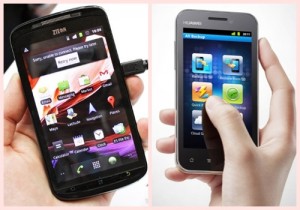 Established vendors such as HTC, Sony and LG Electronics want to set their smartphones apart from less expensive devices from ZTE and Huawei. But as looks and hardware specifications are becoming more similar and software differentiation harder, having a better reputation is their last ace, according to analysts.
Established vendors such as HTC, Sony and LG Electronics want to set their smartphones apart from less expensive devices from ZTE and Huawei. But as looks and hardware specifications are becoming more similar and software differentiation harder, having a better reputation is their last ace, according to analysts.
Mobile World Congress 2012 lacked really big announcements, but offered a plethora of new smartphones in all price ranges. Before the show, Geoff Blaber, an analyst at CCS Insight, said HTC and LG Electronics needed to do a major refresh of their respective portfolio of smartphones, and that they did.
“HTC had a good show and the One X is a very, very strong device, and LG has done as well as anyone expected,” Blaber said on the last day of the event.
But those vendors along with Sony and Motorola Mobility are facing the same problem as before the show. They are being squeezed on one side by Apple and Samsung Electronics’ growing market shares and on the other side by Huawei’s and ZTE’s low pricing, according to Blaber.
The Chinese vendors have a clear strategy, according to Francisco Jeronimo, research manager at IDC.
“They are trying to make their products as similar as possible to ones from established vendors and hope the consumers will go for their cheaper smartphone,” said Jeronimo.
The quality of Huawei’s phones has improved a lot over the last couple of years, although ZTE’s products still lag behind Huawei in that regard, Blaber said.
The established vendors don’t want to compete on price with Huawei and ZTE, so they need to set their products apart, but doing either via software or hardware is increasingly difficult, according to Carolina Milanesi, research vice president at Gartner.
“There isn’t much I have seen that would drive me from one vendor to the next,” she said.
On the hardware side, the focus at this year’s show was very much on processors, especially quad-core, according to Jeronimo.
“It is a race and something that makes headlines,” said Jeronimo, who doesn’t think the addition of two more cores will make much of a difference to users, since there aren’t many applications that can take advantage of them.
But while LG and HTC are releasing smartphones with quad-core smartphones and big screens, so are Huawei and ZTE.
And HTC is getting kudos for its deal with Dropbox, which will integrate cloud storage service on smartphones.
“It is reassuring that HTC is not starting from scratch and trying build their own service,” said Blaber.
HTC also launched Media Link, which allows users to integrate their smartphones with their TVs.
“It is kind of important, because HTC doesn’t have a TV business and everyone is talking about integrating multiple screens,” said Milanesi.
But turning that accessory into an advantage when a user is standing in a store choosing their next device will be a challenge for the company, according to Milanesi.
Now HTC, which still has an edge over Huawei on the quality of the hardware, needs to become more aggressive with its marketing.
“At this point, HTC has to stop being quietly brilliant and be a bit more gutsy in their advertising and really communicate what it stands for,” said Milanesi.
Vendors are also continuing to put their own touch on Android’s user interface, but doing that will not be sustainable, according to Blaber.
“Everyone is moving quite late to Ice Cream Sandwich and Google will likely announce the next version of Android in three four months, and then they are on the back foot again,” said Blaber.
But one thing that Huawei and ZTE still lack are well-known brands.
“Brand is particularly important in the high-end, where phones get more complex and users want either the security or to show off the brand itself,” said Milanesi.
To have a chance of overcoming that the price of ZTE’s and Huawei’s smartphones have to be at least 30 to 40 percent lower, otherwise consumers will go with the brand they know, according to Jeronimo.
But it isn’t just the Chinese companies that want a bigger slice of the smartphone market — at Mobile World Congress Japanese vendors Panasonic and Fujitsu presented smartphones they hope that European operators will pick up. But their chances of becoming successful are slim.
“I think they are going to have a really hard time,” said Milanesi
Jeronimo agreed: “They don’t stand a chance.”
Just like many vendors before them — including Hewlett-Packard, Acer, Toshiba and Dell — they have the impression that strength in the laptop market will translate into success in the handset market, but that just doesn’t work, according to Jeronimo.
The only chance they have to succeed is to spend loads of money on operators to subsidise their own devices and drop prices below those of Huawei, Jeronimo said.
Even if there were many impressive smartphones launched at Mobile World Congress, it remains to be seen how competitive they will be. That question will only be answered when Samsung launches the Galaxy S III, according to Blaber.
“Last year everyone was stunned by what Samsung achieved with the Galaxy S II. It changed the game; it was significantly thinner and had a phenomenal screen,” said Blaber.
Mobile World Congress wasn’t just about Android, though. Nokia continued to build on its Windows Phone portfolio, with the introduction of the less expensive Lumia 610, which will cost €189 (US$254) and be available in the second quarter.
“I think Nokia have done a very good job. No one was expecting to see a device at that price point before 2013,” said Jeronimo.
The speedy arrival of the Lumia 610 shows how well the relationship between Nokia and Microsoft is working, but now they have to continue to put out new models, including even cheaper ones, and develop more services, Milanesi and Jeronimo agree.
“Nokia is only half way through its transition to Windows Phone,” said Jeronimo.
But Nokia will have to face competition from the Chinese vendors, as well. ZTE launched the Orbit, which is also an inexpensive Windows Phone.
“It could turn out to be a real thorn in the side of Nokia,” said Blaber.
Overall, Mobile World Congress was a success. Attendance was up by 11 percent over the previous year, with more than 67,000 visitors, which includes delegates, exhibitors, contractors and the media, from 205 countries, according to organiser GSM Association.
Starting next year, Mobile World Congress will be held at the Fira de Barcelona Gran Via, a move that will provide approximately 50 percent more space, the GSMA said. The event will be held Feb. 25-28.





